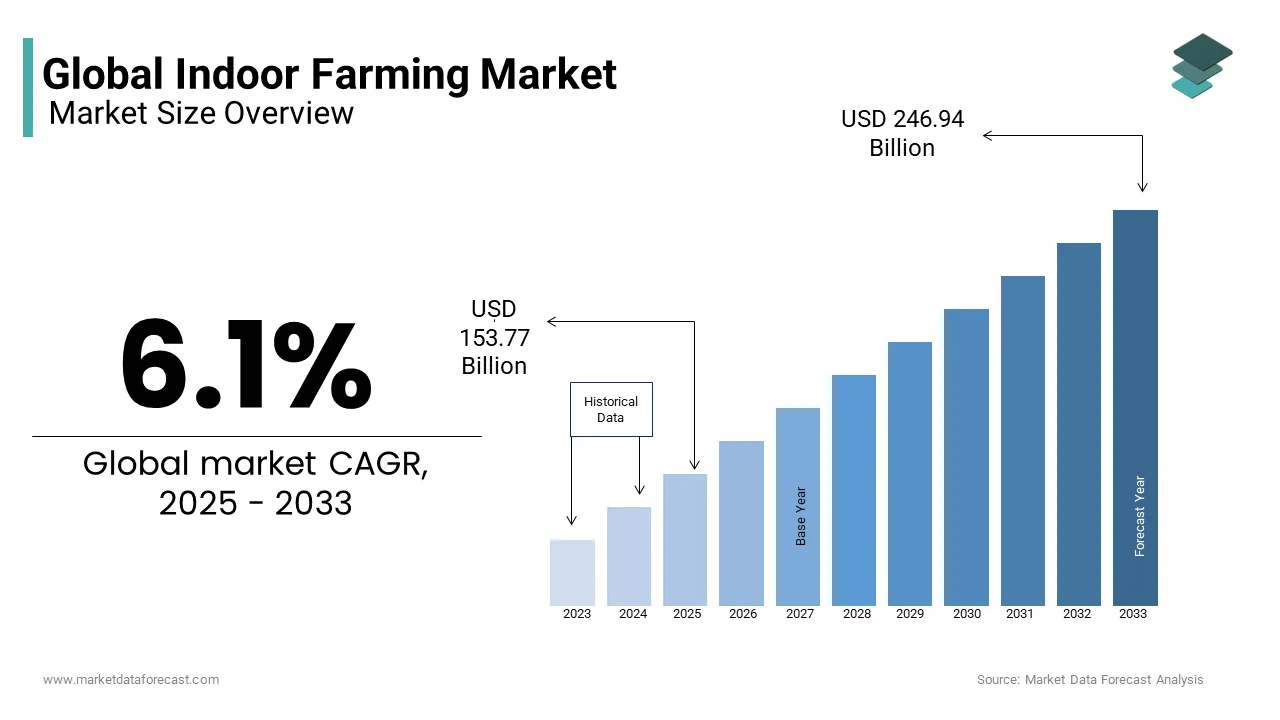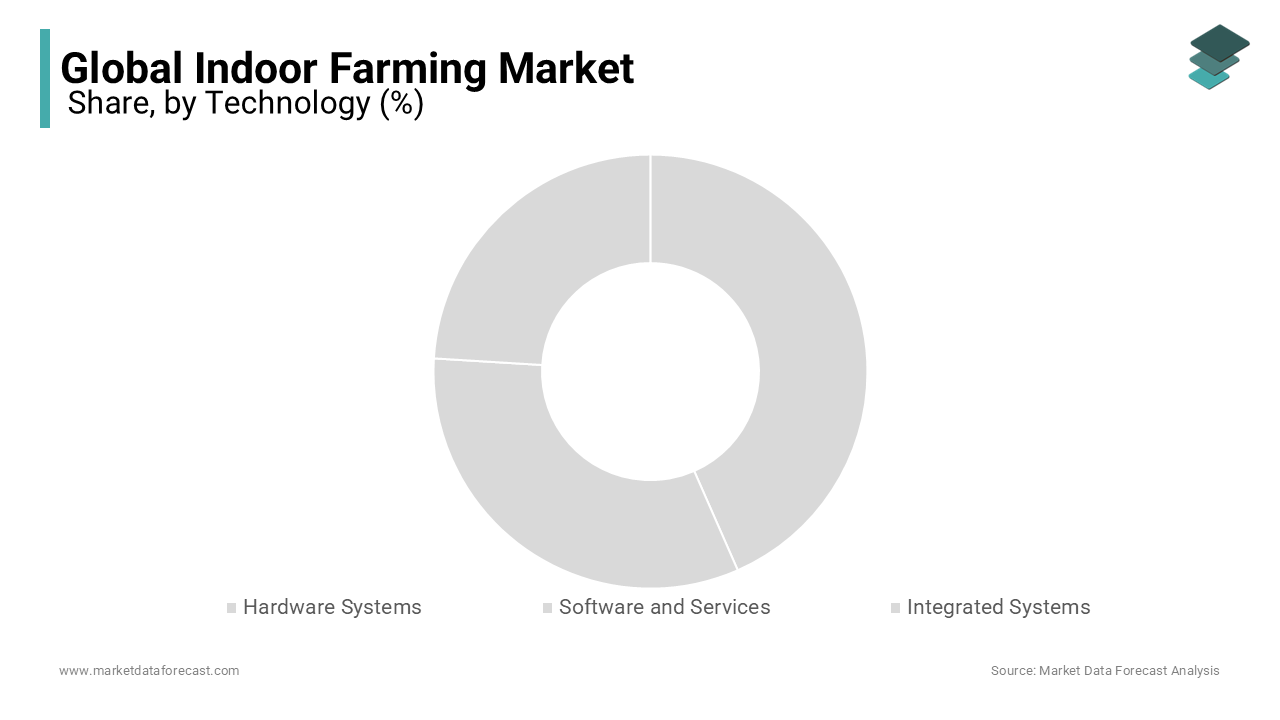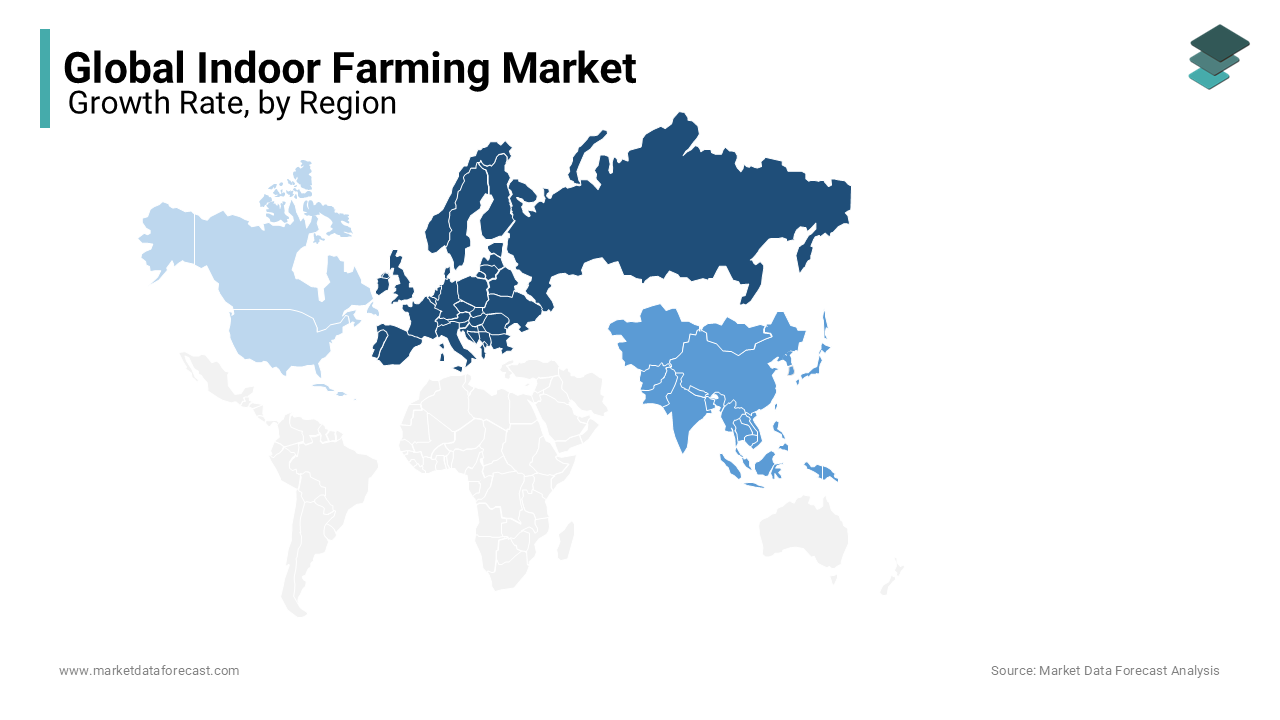Global Indoor Farming Market Size, Share, Trends & Growth Forecast Report Segmented By Technology (Hardware, Software & Services, Integrated System), Installation (Greenhouse, Indoor Vertical Farm, Container Farms), Cultivation Method (Hydroponics, Aeroponics, Aquaponics, Soil-Based and Hybrid), Product (Vegetables, Fruits, Microgreens and Herbs, Medicinal Crop, and Others), (North America, Europe, Asia Pacific, Latin America, and Middle East & Africa), Industry Analysis (2025 to 2033)
Global Indoor Farming Market Size
The global indoor farming market size was valued at USD 144.93 billion in 2024, and it is anticipated to reach USD 153.77 billion in 2025, growing at a CAGR of 6.1% from 2025 to 2033, and it is anticipated to reach USD 246.94 billion by 2033.

Indoor farming is a type of modern agriculture for growing crops or plants in a closed and protected environment. Domestic agriculture is exploited on both small and large scales. It protects the farm from the vagaries of bad weather, which generally acts as an obstacle to the production of conventional crops. Indoor farming is widely practiced in urban areas due to the limited space for agriculture.
Indoor farming is a technology-based farming practice that involves the utilization of a controlled environment for cultivating crops in an enclosed space. Indoor farming involves various methods such as vertical farming, hydroponics, and aeroponics, which provide artificial lighting, a liquid nutrient solution without soil, less water, and land use for crop cultivation. The global indoor farming market has accounted for significant growth in the past years and is anticipated to witness notable growth during the forecast period. Indoor farming helps farmers control the growth conditions and provides them with efficient nutrients and requirements necessary for plant production. Indoor farming enables farmers to cultivate crops all year without the risk of yield loss due to adverse weather conditions, and it also helps in avoiding pest infections or genetic crop diseases. According to various data sources, by 2050, around 80 percent of the world’s population will live in urban areas, which demands indoor farming practices leading to market growth.
MARKET DRIVERS
The Shortage of Arable Land
Several countries have been facing a shortage of arable land mainly due to land degradation, land transformation for infrastructure and human settlements, and various social and climatic factors. The concept of indoor farming has brought about a paradigm shift in food production with the minimization of land use. Due to the new growth mechanisms in indoor agriculture, such as hydroponics, aeroponics, aquaponics, soil-based, and hybrids, it is estimated that the market will multiply during the forecast period. According to the World Bank database, the total area of arable land per capita decreased from 0.199 hectares in 2010 to 0.192 hectares in 2016. The Food and Agriculture Organization of the United Nations has reported that land degradation is the main factor driving the reduction of global arable land. Singapore has set an example by optimizing its use of agricultural land through vertical farming as part of its Food Security Roadmap, which is the result of the 43rd Commission on World Food Security held in 2016. The Different benefits of greenhouse and vertical indoor agriculture, such as limited land use, year-round cultivation, and longer lifespan, stimulate the global indoor farming market, especially in belts from Asia-Pacific and Africa.
Growing Need to Reduce the Use of Herbicides and Pesticides in Crop and Plant Production
Indoor farming seems to be more attractive because of its ability to produce more agricultural products with fewer human resources. The growing concern for food security around the world is one of the main trends that should stimulate the global indoor farming market. Growing awareness of the benefits of indoor farming among end-users compared to conventional agriculture has triggered market growth. The scarcity of land for agriculture favors the indoor agriculture market in the world.
Furthermore, the increasing demand for food supply, the growing human population in urban areas, the cost-effective method of farming, protection from weather variations, the reduction of terrestrial insects as well as the problems of herbicides and pesticides in agricultural production are propelling the indoor farming market growth. Collaboration with suppliers of agricultural products and investments in R&D should create significant opportunities for indoor farming market growth in the coming years. The indoor farming market is gaining popularity due to rising consumer awareness about the benefits of high-quality and freshly produced food. Also, the demand for food has increased because of the growing population worldwide and in emerging nations like China and India. Hence, the market is predicted to propel in the upcoming years. Another driving factor for the indoor farming market is the current environmental issues. This includes worsening soil erosion and groundwater depletion with changing climates. So, it has an impact on the systems producing food and agriculture. In addition, government support for the development is aimed at resolving this issue, which is fueling the market expansion. Moreover, people’s perception that organic food is safer, has more nutrients, is healthier, and is environmentally beneficial is pushing the market forward. In addition, private investment in indoor farming has reached over $1.6 billion in the US alone in recent years, indicating the industry's growth.
MARKET RESTRAINTS
The main constraints of the global indoor farming market are high initial investments and limitations on crop varieties. According to regional indoor farming regulators, the controversy over organic certification is likely to be a problematic factor in the expansion of the global indoor farming market. The growth of the indoor farming market is derailing due to energy costs, limited crop focus, regulatory hurdles, and operational efficiency. These are some of the prominent factors which continue to affect the customers. In 2022, vertical farming in Europe faced difficulties due to the exorbitant expense of maintaining LED lights and climate control systems. Furthermore, Agricool of France, which had raised thirty million euros, filed for bankruptcy. It operates in the UK, France, Germany, the Netherlands, and Denmark. Infarm, which was formerly the largest vertical farming company in Europe, raised over 600 million US dollars in venture capital. However, in late 2022, the company laid off 500 employees due to factors such as supply chain disruptions, power costs, and the overall state of the economy. Also, Infarm cut ties with European supermarket chains in June and intended to pull out of the continent completely in favor of other areas, most likely the Middle East.
Expensive plants with short production cycles and little to no competition are the ideal candidates for vertical farming. High-income cities with thriving hotel, catering, and restaurant (HoReCa) industries are home to numerous prosperous vertical farms. Profitable vertical farms are frequently affiliated with HoReCa organizations with which they collaborate.
REPORT COVERAGE
|
REPORT METRIC |
DETAILS |
|
Market Size Available |
2024 to 2033 |
|
Base Year |
2024 |
|
Forecast Period |
2025 to 2033 |
|
CAGR |
6.1% |
|
Segments Covered |
By Technology, Type of installation, Cultivation Methods, Type of Product, and Region. |
|
Various Analyses Covered |
Global, Regional, & Country Level Analysis; Segment-Level Analysis; DROC, PESTLE Analysis; Porter’s Five Forces Analysis; Competitive Landscape; Analyst Overview of Investment Opportunities |
|
Regions Covered |
North America, Europe, APAC, RoW |
|
Market Leaders Profiled |
Richel Group (France), Netafim (Israel), LumiGrow (United States), Illumitex (United States), Hydrodynamics International (United States), Agrilution (Germany), and Argus Control System Limited (Canada), among Others. |
SEGMENTAL ANALYSIS
By Technology Insights

The hardware segment dominated the global indoor farming market with a prominent share and is expected to witness a prominent CAGR during the forecast period. The hardware components play an important role in the maintenance of indoor farms as they consist of lighting systems, climate control, temperature regulation, sensors, irrigation systems, and others, which boost the segment growth rate. The farmers are in high demand for climate control systems due to their comprehensive benefits of creating a conducive environment required for plant growth, augmenting the segment growth opportunities. The hardware components include heaters, chillers, air-conditioning units, fans, solar lights, etc.
The software segment is estimated to have notable growth during the forecast period owing to acceleration in the enhancement of farming technologies. The software involves the fruit and vegetable data, crop batch, area of land, supplier, and distribution information fueling the segment growth. The software consists of web-based and cloud-based systems that help determine and collect data on environmental parameters, contributing to segment growth.
By Type of Installation Insights
The vertical indoor farms segment held the most significant share of the indoor farming market due to the increasing adoption of environment-friendly farming practices. Due to changing consumer preferences, the growing demand for organic food products drives the segment growth opportunities. Vertical indoor farms help to cultivate high crop production in the limited landscape with advanced technologies, artificial environments, and limited resources, which is the primary factor escalating the segment expansion.
The greenhouses segment is expected to grow considerably during the forecast period due to its closed environment, which enhances crop production quality and quantity. The greenhouses are projected to provide high-yield production compared to traditional farming practices, boosting the segment growth opportunities.
By Cultivation Methods Insights
The hydroponics segment dominated the global market with a notable growth rate and is expected to remain dominant during the forecast period. Hydroponics is the most popular farming technique among farmers, and it has low installation costs and ease of operation, which is a significant factor contributing to market growth. Hydroponicslizes limited water, requires less labor, and produces high-quality food with no soil, which are factors escalating the segment growth.
The Aquaponics segment is projected to witness significant CAGR during the forecast period. Aquaponics is a combination of hydroponics and aquaculture, and this method avoids using harmful chemicals for cultivation, increasing growth opportunities.
By Type of Product Insights
The vegetables and fruits segment dominated the global indoor farming market revenue with a prominent share owing to increased consumer demand for these products. Fruits and vegetables are the most commonly consumed food products that demand high production and provide maximum profit for cultivation, augmenting the growth rate. The tomatoes held the most prominent share in the vegetable segment, enhancing the cultivation rate among the farmers and leading to segment expansion.
The microgreens and herbs segment are expected to account for the considerable growth during the forecast period. Green and leafy vegetables are gaining high demand from consumers due to the increased health benefits provided by these vegetables, which are propelling market growth.
REGIONAL ANALYSIS

The European region held the most notable growth rate in the indoor farming market due to the presence of advanced farming technologies across the region. The region is expected to record the highest CAGR in the coming years due to increasing initiatives for enhancing indoor farming practices, such as the introduction of Controlled Environment Agriculture (CEA), boosting the opportunities for regional market growth. Various factors such as climatic changes, growing population, growing concerns about the environment, and rising demand for food production rates have enhanced the government bodies to take initiatives for developing indoor farming practices, leading to regional market revenue growth. The UK is facing various challenges regarding arable land and changing climatic conditions, as well as enhancing and adopting indoor farming practices, contributing to the market growth in the region.
The Asia Pacific region is estimated to have a rapid growth rate during the forecast period. Regional countries such as China, India, and Japan are expected to witness notable growth in the coming years due to the growing adoption of advanced technologies in indoor farms, which are driving market growth opportunities. The rising population across the region and the growing awareness among the people are enhancing the demand for organic food, accelerating the growth opportunities in the market.
The North American region is projected to grow considerably in the coming years due to rising demand for natural and pesticide-free food products. The presence of advanced technological infrastructure in the agriculture industry contributes to regional market growth opportunities. The rising initiatives by the farmers to invest in advanced farming techniques are enhancing the regional market growth.
KEY MARKET PLAYERS
Richel Group (France), Netafim (Israel), LumiGrow (United States), Illumitex (United States), Hydrodynamics International (United States), Agrilution (Germany), Argus Control System Limited (Canada), among others. These are some of the market players dominating the global indoor farming market. These companies had a significant market share in 2023. The other important players are Signify Holding (Netherlands), Osram GmbH (Germany), and EVERLIGHT Electronics (Taiwan). The presence of many industry players should contribute to intense competition in the international marketplace.
RECENT HAPPENINGS IN THIS MARKET
- Bowery, a start-up company in indoor farming, has recently converted Franklin Square Drive's industrial warehouse into a modern farm in Baltimore. This is registered as the largest farm so far for this company, which is based in New York.
- CRISPR Technology implemented indoor vertical farming methods for various fruits like strawberries, raspberries, grapes, kiwi fruit, and so on. They are envisioned to bring crops like chocolate, mango, and almonds to indoor cultivation soon.
- In January 2023, Priva announced its partnership with Aranet, where the primary aim is to serve the growing demand for more greenhouse sensors for data generation.
- In February 2023, Kroger announced the extension of its partnership with Gotham Greens, an indoor farming business. The Gotham Greens supplied vegetables and plant-based dips, cooking sauces, and dressings to the Kroger stores.
MARKET SEGMENTATION
This research report on the global indoor farming market is segmented and sub-segmented based on technology, type of installation, cultivation method, type of product and region.
By Technology
- Hardware Systems
- Software and Services
- Integrated Systems
By Type of Installation
- Greenhouses
- Vertical Indoor Farms
- Container Farms
- Others
By Cultivation Methods
- Hydroponics
- Aeroponics
- Aquaponics
- Soil-based and hybrid
By Type of Product
- Vegetables
- Fruits
- Microgreens and Herbs
- Medicinal Crops
- Others
By Region
- North America
- Europe
- Asia Pacific
- Latin America
- Middle East and Africa
Frequently Asked Questions
What is the current market size of the global indoor farming market?
The current market size of the global indoor farming market size was valued at USD 153.77 Bn by 2025
What are the market drivers that are driving the global indoor farming market?
The shortage of arable land is promoting the growth of the global indoor farming market, and The growing need to reduce the use of herbicides and pesticides in crop and plant production is expected to gain popularity in the indoor agriculture market.
Who are the market players that are dominating the global indoor farming market?
Richel Group (France), Netafim (Israel), LumiGrow (United States), Illumitex (United States), Hydrodynamics International (United States), Agrilution (Germany), Argus Control System Limited (Canada), among others.
Related Reports
Access the study in MULTIPLE FORMATS
Purchase options starting from $ 2500
Didn’t find what you’re looking for?
TALK TO OUR ANALYST TEAM
Need something within your budget?
NO WORRIES! WE GOT YOU COVERED!
Call us on: +1 888 702 9696 (U.S Toll Free)
Write to us: [email protected]